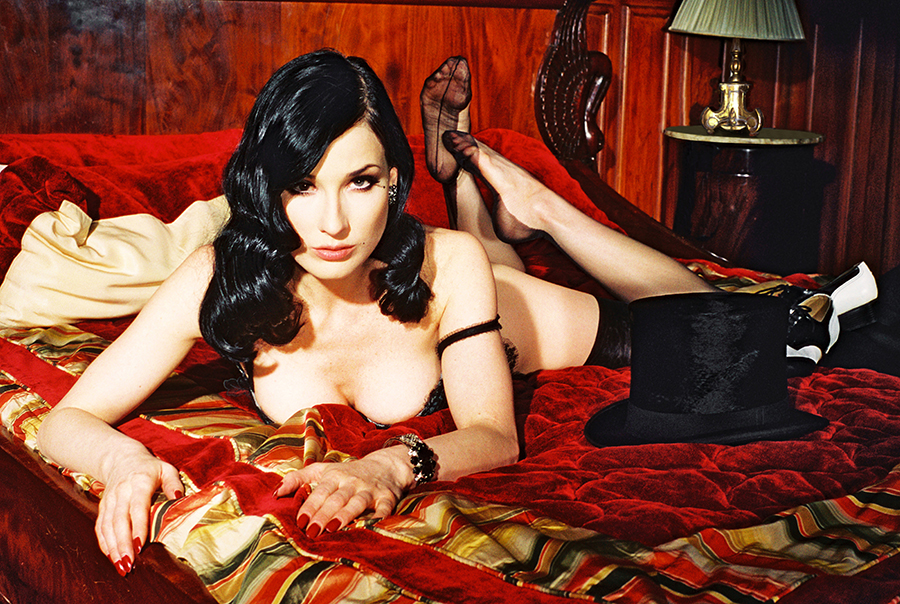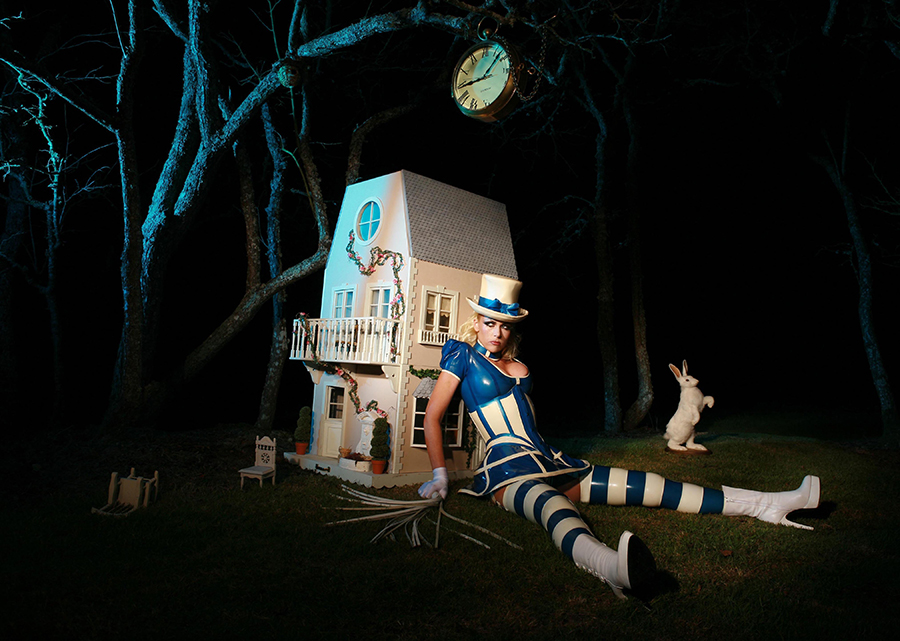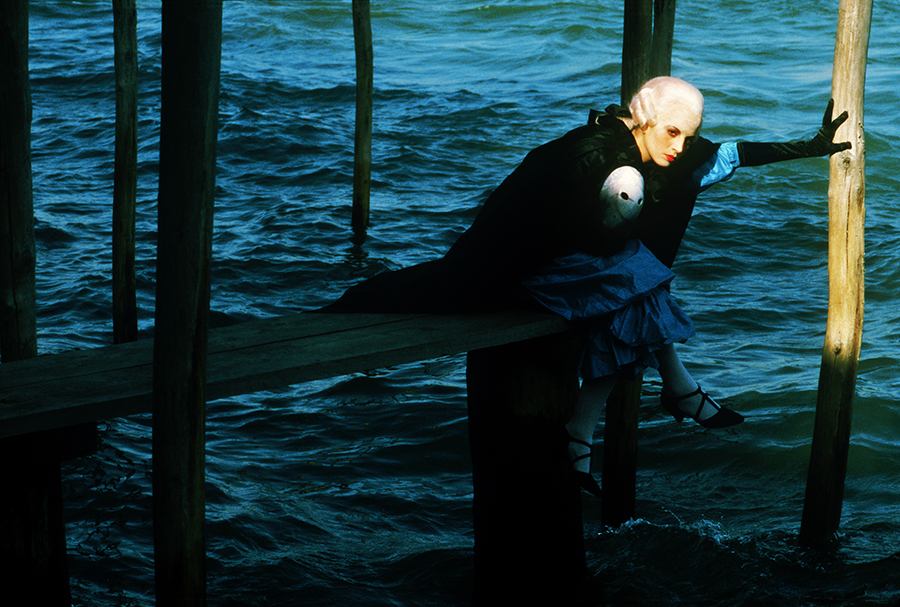[EN] Born on April 29, 1959, Christophe Mourthé began as a theater and music-hall photographer at the age of 19. He finds his inspiration at Zeffirelli, Peter Stein, Giorgio Strehler, Dario Fo, Peter Brook, Frederico Fellini.
To those who ask him who his « masters » are, he prefers to mention these names, rather than a Newton or a Doisneau. Christophe Mourthé is a visionary, who perceives very quickly that the trends of society are rapidly changing rapidly in the early 80s. He quickly becomes un precursor of the school of « fetichits », absorbed later by advertising. The fetichism of Christophe Mourthé becomes a style in its own, heralding of a trend of fashion that will seize the haute couture later. His photos are rooted in both the tumultuous period of freedoms of the 70s, and in the « safe sex » period that will slow down the momentum of this period. Some new ways to live love are bonr, and fetichism is one of them. Christophe Mourthé belongs alose and mostly to the « Palace » generation, just like Mugler, Gaultier, Chantal Thomass, Nina Hagen, Blondie, Ardisson, Paolo Calia, Pacadis, Kenzo, Houellebecq, Pierre et Gilles , Lou Boutin… whose Fabrice Emaer was the spiritual father.
Christophe Mourthé rightly considers that the « Palace » period (1978 to 1983) brought him a certain blooming, another vision of life, sex and his freedoms. Ths allowed him to learn and personalize this own vision of art. « Those how lived in the Palace have made their lives a work of art »
The erotic imagery of Christophe Mourthé is one of the most spectacular results.
Fashion industry alse uses him. He collaborates with the biggest magazines (Playboy, at the age of 22, he was one of the main photographers of the magazine, Penthouse, New Look, Lui, Vogue, Mac) for which he photographs the most fashionable models to the rythm of his dreamlike images. Then come orders from the world of advertising (Dim, Rosy … ), the major news agencies (Stills, Sipa, Sygma … ) and record compagnies (Pouches, posters … ). He creates a serie of portraits that strike as much by their authenticity (Mylène Farmer, Renaud, Higelin, Nougaro, Dick Annegarn, César, Hugues Aufray,Zeffirelli, Gassman ou Jean Marais among others) than by the staging as the service of the artist (Arielle Dombasle as the Statue of Liberty, Jean-Marie Bigard as Rodin’s ‘Thinker’)
Patricia Kass, Hélène Séguara, Sheila, Michelle Torr, Pétula Clark, Jean Manson, Victor Lazlo, Lio, Line Renaud, Zizi Jeanmaire, Madame Clause, Ute Lemper, Dita von Teese all will pass in front of his lens.
It is he who will reveal Marlène as an image pin up on glossy paper.
By the quality of his work, Christophe Mourthé brings out the fetichism of his X ghetto at the dawn of the 90s before it was seized by the publicists. In 1993, an exhibit is organized in Paris and the photo book « Phyléa », considered as the book of the year in Europe, will sell to more than 17000 copies. He creates in photos the comic’s erotic univers. The fetichism becomes accessible to the public. We display and exhibit it. The press is unanimous. « Fetish Dream » is published in Japan in 1994 et quickly become a collectible. The same year, Christophe Mourthé exhibits in Los Angelès and publishes « Marlène Love » in France.
In 1998, he publishes a new book « Femmes Fatales » and a 3D CD-ROM dedicated to the fetishist milieu in collaboration with Boutique Minuit, the high place of the fetish scene in Brussels. Every porn star call on the glamorous photographer who brings out in a sublime and idealized way their most intimate self and gives them an image that projects them in other media than those of the ghetto X.
In particular, Julia Channel and Clara Morgane will benefit from his work.
In 2001, Christophe Mourthé takes another path and turns a trilogy X produced by Colmax. On screen, his style is just as inimitable. The fusion of aesthetics and hardness gives birth to unique works, characterized by ‘a sophisticated style, elegant, sometimes provocative, but always dotted with class and humor’. The launch of ‘Sex Me’ is a sensation. « True » sex, but without ever spoiling the universe characteristic of the author, » writes Dutilleul in HotVideo.
« Colorsex » and « Amazonesex » will follow, then a very personnal Kamasutra, which is nowadays an absolute reference of an erotic pratice.
Les Editions de la Musardine publish « Scandal », with photos from every models who inspired the artist for the last twenty years.
in 2002, for the first time, a hundred of Christophe Mourthé photographics prints are sold at the Lutétia Hotel in Paris under the supervision of Maitre Cornette de Saint Cyr, master auctioneer and leading European expert in the field of photography. contemporary art.
An apotheosis and an unforgetable moment !
A year later, Canal + entrusted Christophe Mourthé with the production of three feature films. « Aphrodite’s Castle » with Mélanie Coste, « The duel of Aphrodite » with Katsumi and « The mystery of Aphrodite » with Tiffany Hopkins, supported by the original music of Gérard Tellier, are shot in the most beautiful castles of Bohemia and create with the viewer an intimate relationship, devoid of any vulgarity, that appeals to the public, whether male or female. About these three films, Christophe Mourthé says: « By turning the three Aphrodites, I tried to idealize the animated image by making it full of glamor and tenderness, indomitable and sensual, and I hope to have succeeded. My biggest disappointment would be that a woman would be disappointed in the way I interpreted it, my goal has always been to portray the woman in an ideal way, but without making it inaccessible, in my opinion, Aphrodite is an example. the most successful … »
By conducting the retrospective exhibition at the Knokke-Heist Cultural Center in Belgium, Christophe Mourthé succeeds Newton, David Bailey and Sam Lévin.
All of his work has been successfully presented in giant formats. A prestigious catalog keeps this exhibition in memory.
[FR] Né le 29 avril 1959, Christophe Mourthé débute comme photographe de théâtre et de music-hall à l’âge de 19 ans. Il trouve son inspiration chez Zeffirelli, Peter Stein, Giorgio Strehler, Dario Fo, Peter Brook, Frederico Fellini.
À ceux qui lui demandent aujourd’hui quels sont ses « maîtres », il préfère citer ces noms-là, plutôt qu’un Newton ou un Doisneau. Christophe Mourthé est un visionnaire qui perçoit bien vite que les tendances de la société sont en pleine mutation au début des années 80. Il devient rapidement un précurseur de l’école des ‘fétichistes’, absorbée plus tard par la publicité. Le fétichisme de Christophe Mourthé devient un style à part entière, annonciateur d’une tendance de la mode dont s’emparera plus tard la haute couture. Ses photos sont enracinées tout à la fois dans la période tumultueuse des libertés des années 70 et dans la période du « safe sex » qui allait donner un coup de frein à l’élan de cette décennie. De nouvelles manières de vivre l’amour voient le jour, et le fétichisme est l’une d’entre elles. Christophe Mourthé appartient aussi et surtout à la génération « Palace », tout comme Mugler, Gaultier, Chantal Thomass, Nina Hagen, Blondie, Ardisson, Paolo Calia, Pacadis, Kenzo, Houellebecq, Pierre et Gilles , Lou Boutin… dont Fabrice Emaer fut le père spirituel.
Christophe Mourthé considère à juste titre que cette période du Palace (1978 à 1983) lui a apporté un certain épanouissement, une autre vision de la vie, du sexe et de ses libertés. Cela lui a permis de d’apprendre et personnaliser sa propre vision de l’art. « Ceux qui ont vécu le Palace ont fait de leur vie une œuvre d’art ».
L’imagerie érotique de Christophe Mourthé en est l’un des résultats les plus spectaculaires.
L’industrie de la mode fait également appel à lui. Il collabore avec les plus grands magazines (Playboy, – à 22 ans, il est l’un des principaux photographes du magazine -, Penthouse, New Look, Lui, Vogue, Max…), pour lesquels il photographie les modèles les plus en vogue au rythme de ses images oniriques. Arrivent ensuite des commandes pour le monde de la publicité (Dim, Rosy…), les grandes agences de presse (Stills, Sipa, Sygma…) et les maisons de disques (pochettes, affiches…). Il crée une série de portraits qui frappent tant par leur authenticité (Mylène Farmer, Renaud, Higelin, Nougaro, Dick Annegarn, César, Hugues Aufray,Zeffirelli, Gassman ou Jean Marais entre autres ) que par la mise en scène au service de l’artiste (Arielle Dombasle en statue de la liberté, Jean-Marie Bigard en ‘Penseur’ de Rodin)
Patricia Kass, Hélène Séguara, Sheila, Michelle Torr, Pétula Clark, Jean Manson, Victor Lazlo , Lio, Line Renaud, Zizi Jeanmaire , Madame Claude, Ute Lemper, Dita Von Teese passeront devant son objectif.
C’est lui qui révélera Marlène en pin up de l’image sur papier glacé.
Par la qualité de son œuvre, Christophe Mourthé fait sortir le fétichisme de son ghetto du X à l’aube des années 90, bien avant que la publicité ne s’en empare. En 1993, une exposition est organisée à Paris et l’album « Phyléa », considéré comme le livre de l’année en Europe, se vendra à plus de 17 000 exemplaires. Il recrée en photos l’univers de la bande dessinée érotique. Le fétichisme devient accessible au grand public. On le montre et on l’exhibe. La presse est unanime. « Fetish Dream » est publié au Japon en 1994 sera rapidement un collector. La même année, Christophe Mourthé expose à Los Angeles et publie aussi « Marlène Love » en France.
En 1998, il publie un nouveau livre « Femmes Fatales » et un CD-ROM en 3D consacrés au milieu fétichiste en collaboration avec Boutique Minuit, le haut lieu de la scène fétichiste à Bruxelles. Toutes les stars du X font appel au photographe glamour qui fait ressortir de manière sublime et idéalisée leur moi le plus intime et leur donne une image qui les projette dans d’autres médias que ceux du ghetto X.
Julia Channel et Clara Morgane en particulier profiteront de son travail.
En 2001, Christophe Mourthé emprunte une autre voie et tourne une trilogie X produite par Colmax. À l’écran, son style reste tout aussi inimitable. La fusion de l’esthétisme et du ‘hard’ donne naissance à des œuvres uniques, caractérisées par ‘un style sophistiqué, élégant, parfois provocateur, mais toujours parsemé de classe et d’humour’. Le lancement de ‘Sex Me’ fait sensation. « Du sexe ‘véritable’, mais sans jamais gâcher l’univers caractéristique de l’auteur », écrit Dutilleul dans HotVidéo.
Suivront « Colorsex » et « Amazonesex », puis un Kamasutra très personnel aujourd’hui référence absolue d’une pratique érotique.
Les Éditions de la Musardine publient « Scandal », avec des photos de tous les modèles qui ont inspiré l’artiste au cours des 20 dernières années.
En 2002, pour la première fois, une centaine d’œuvres photographiques de Christophe Mourthé sont mises en vente à l’hôtel Lutétia à Paris sous la direction de Maître Cornette de Saint Cyr, maître priseur et expert européen de premier plan en matière d’art contemporain.
Une apothéose et un moment inoubliable!
Un an plus tard, Canal+ confie à Christophe Mourthé la réalisation de trois longs-métrages. « Le château d’Aphrodite » avec Mélanie Coste, « Le duel d’Aphrodite » avec Katsumi et « Le mystère d’Aphrodite » avec Tiffany Hopkins, appuyés par la musique originale de Gérard Tellier, sont tournés dans les plus beaux châteaux de Bohème et créent avec le spectateur une relation intime, dénuée de toute vulgarité, qui interpelle le public, qu’il soit masculin ou féminin. Au sujet de ces trois films, Christophe Mourthé déclare: « En tournant les trois Aphrodite, j’ai tenté d’idéaliser l’image animée en la rendant pleine de glamour et de tendresse, indomptable et sensuelle, et j’espère avoir réussi. Ma plus grande déception serait qu’une femme soit désappointée de la manière dont je l’ai interprétée. Mon but a toujours été de représenter la femme de manière idéale, mais sans la rendre inaccessible. À mon sens, Aphrodite en est l’exemple le mieux réussi… »
En réalisant l’exposition rétrospective au Centre culturel de Knokke-Heist en Belgique, Christophe Mourthé succède à Newton, David Bailey et Sam Lévin.
L’ensemble de son œuvre y a été présenté avec succès dans des formats géants. Un catalogue prestigieux garde en mémoire cette exposition.




